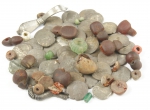Wtórek
Wtórek, Ostrów Wielkopolski District – a hoard found in 2015 during a development-led archaeological excavation associated with the construction of a ring road for Ostrów Wielkopolski, in a site with evidence of repeated prehistoric and early medieval occupation. The objects belonging to the deposit had been ploughed out to some extent, with some evidence of patina apparently caused by exposure to high temperatures associated with production activity confirmed in some early medieval pits adjacent to the site of the discovery of the hoard. From an archaeological surface survey made on the same site in 2012 comes another deposit; the chronology of 67 Roman denarii belonging to it is the same as the dating of coins belonging to the 2015 group find.
The denarii date to the period between the second half of the 1st and the end of the 2nd century. Nevertheless, the brooches present in the hoard establish the time of its deposition as early →Migration Period. The small assemblage of coins and jewellery consists of 39 denarii, glass and amber beads (26 complete and a dozen-odd fragmented) and fragments of metal personal ornaments, more notably, three silver brooches, two of them better preserved.
The coins in the hoard include a small group (four) issues of Flavian emperors (69–96): Vespasian (3) and Domitian (1), and a much larger series (35) of issues of Antonine emperors (96–192): Trajan (1), Hadrian (4), Antoninus Pius (14) Marcus Aurelius (9), Lucius Verus (1) and Commodus (6).
The glass beads and lathe-turned amber beads represent various forms that were in use between the mid-3rd and the first half of the 5th century.
The two better preserved silver brooches are bipartite forms with an opening for the axle in their head. One (L. 5.25 cm) has a bow fashioned from a strip of metal sheet tapering to its ornate foot, diamond-shaped, with a folded catchplate. The design on the foot is built by engraved, intersecting double lines. This brooch type was particularly popular in the Gothic environment between the mid-3rd and the onset of the 5th century. The other brooch (L. 3.1 cm) has a wire-wrapped bow, a facetted foot decorated with metopes and a solid catchplate. It resembles in its form type Prag brooches, although it appears to be a little younger than they – this is suggested by its design and dimensions. The artefacts are now in the regional museum (Muzeum Okręgowe Ziemi Kaliskiej) in Kalisz (the deposit)
Literature: A. Bursche, K. Kowalski (ed.), Barbarian Tsunami. Migration Period between the Odra and the Vistula, Warszawa-Szczecin, 2017.
Leszek Ziąbka
Muzeum Okręgowe Ziemi Kaliskiej w Kaliszu
-
 full resolution
full resolution
Phot. 1. Hoard found at Wtórek (Wielkopolskie Voivodeship; phot. A. Kędzierski).


